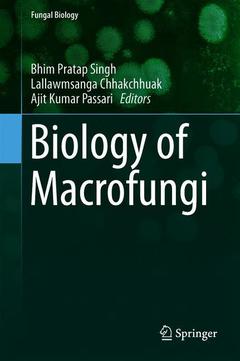Description
Biology of Macrofungi, 1st ed. 2018
Fungal Biology Series
Coordinators: Singh Bhim Pratap, Lallawmsanga , Passari Ajit Kumar
Language: English
Subjects for Biology of Macrofungi:
Support: Print on demand
Description
/li>Contents
/li>Biography
/li>Comment
/li>
Mushrooms are fleshy fungi with a high prospective for the production of secondary metabolites including extracellular enzymes with high agricultural and biotechnological significance. Worldwide, they are well recognized as supplementary foods due to their high nutritional values and their medicinal importance, which includes their uses in exhibiting antioxidant and antimicrobial activities, immune enhancer, and to be effective for the treatment of several diseases including diabetes and few types of cancers as well. According to recent studies, extracellular enzymes produced by several white-rot fungal strains such as Phanerochaete chrysosporium, Pleurotus sajor-caju and several mushrooms have shown a high capacity to decolorize dyes that are very harmful for the environment. Moreover, wild macrofungi have the capability to synthesize nanoparticles which are more useful for the treatment of cancer, gene therapy, DNA analysis and biosensors. Wild macrofungi are extremely important model for basic biology and commercial manufacture.
2. A Global Overview of Edible Mushrooms
Malarvizhi Kaliyaperumal, Kezhocuyi Kezo and Sugantha Gunaseelan
3. Molecular characterization of wild mushrooms: a paradigm shift from morphotyping
Madhusmita Borthakur and S.R. Joshi
4. Antimicrobial and hepatoprotective activities of edible mushrooms
Jasmina Glamočlija, Marina Kostić and Marina Soković
5. Mushroom-mediated Protection from Oxidative Damage to DNA
John A Buswell
6. Chemical and bioactive profiling of wild edible mushrooms
Katarzyna Sułkowska-Ziaja, Katarzyna Kała, Jan Lazur and Bożena Muszyńska
7. Biotechnological requirements for the commercial cultivation of macrofungi: substrate and casing layer
Maria L. Tello, Margarita, Gail Preston, Jaime Carrasco and Perez
8. Role of mushroom fungi in decolourization of industrial dyes and degradation of agrochemicals
Sachin Gupta, Sudheer K. Annepu, Baby Summuna, Moni Gupta and Sunil A Nair
9. Mushrooms: Isolation and purification of exopolysaccharides
Yuxiao Wang, Xiaojun Huang and Shaoping Nie
10. Novel prospective of wild mushroom polysaccharides as potential prebiotics
Yuxiao Wang, Xiaojun Huang and Shaoping Nie
11. Pharmaceutic prodigy of ergosterol and protein profile of Ganoderma lucidum
Anna Goyal and Anu Kalia
12. Application of Wild Macrofungi as Anticancer Therapeutics
Cheong, Peter Chiew Hing, Tan, Chon Seng, Fung and Shin Yee
13. Recent advances in cultivation of edible mushrooms
Meena Kapahi
14. Medicinal mushrooms: Cultivation and pharmaceutical impact
Cheong, Peter Chiew Hing & Fung, Shin Yee, Tan, Chon Seng, Fung and Shin Yee
15. Biological control of microbial pathogens in edible mushrooms
Gail M. Preston, Jaime Carrasco, Francisco J. Gea and María J. Navarro
16. Cordycepin: A biotherapeutic molecule from medicinal mushroom
Mohammad Soltani, Roslinda Abd Malek, Nagib A. Elmarzugi, Mohamad Fawzi Mahomoodally, Davin Uy, Ong Mei Leng and Hesham A. El-Enshasy
17. Biosynthesis of Nanoparticles using Mushrooms
Anu Kalia and Gagandeep Kaur
18. Bioconversion and Biotransformation Efficiencies of Wild Macrofungi
Aparecido Almeida Conceição, Joice Raisa Barbosa Cunha, Vandinelma Oliveira Vieira, Rubén Darío Romero Pelaéz, Simone Mendonça, João Ricardo Moreira Almeida, Eustáquio Souza Dias, Euziclei Gonzaga de Almeida and Félix Gonçalves de Siqueira
19. Wild macro-fungi from Northwest Himalayas: Future prospects and challenges
Monika Thakur
Index
Bhim Pratap Singh
Dr. Bhim Pratap Singh working as Assistant Professor in the Department of Biotechnology, Aizawl, Mizoram University, India, has more than 10 years of research experience in the field of molecular microbiology, biocontrol of plant diseases, mushroom diversity, biosynthetic potential of actinobacteria and fungi associated with medicinal plants. He has worked for last 10 years on microbial diversity and explored the microbial population associated with medicinal plants and rhizospheric soils. His group has documented the wild mushroom of from Mizoram, Northeast India. He has completed seven externally funded research projects on screening and characterization of endophytic actibacteria and fungi associated with medicinal plants and the rhizospheric soils funded by several funding agencies. Dr. Singh has organized several international and national conferences and seminars including India-UK scientific seminar jointly funded by the British Council and the Department of Science and Technology (DST), New Delhi. Dr. Singh has been awarded with several honors like young scientist award in 2014 from Scientific and education Research Society, India and Best achievement award for the contribution to the Asian PGPR society, USA. Dr. Singh is serving ad editors of several reputed peer reviewed scientific journals like Frontiers in Microbiology, Plos ONE etc., and he is an active member of several national and international professional bodies like Asian PGPR Society, Association of Microbiologists of India, MSI, ISCA etc.. His group has published more than 45 research papers in SCI journals and 16 book chapters in the books published by national and international publishers. Dr. Singh has also edited two books published from Springer and Elsevier publications. Dr. Singh has guided 4 Ph.D students and 3 M.Phil students till date.
Lallawmsanga Chhakchhuak
Mr. Lallawmsanga is pursuing Ph.D. at the Department of Bio
Provides information on macrofungi ranging from morphological identification and molecular diversity to biotechnological approaches beneficial for industrial and medical fields
Features over 100 figures and colored images illustrating the diversity of wild macrofungi
Emphasizes present research on macrofungi and its future prospects




